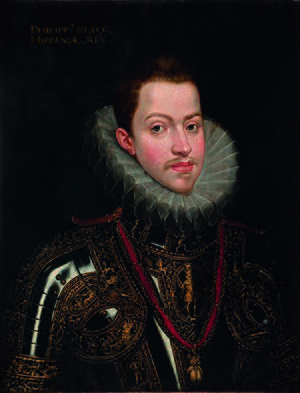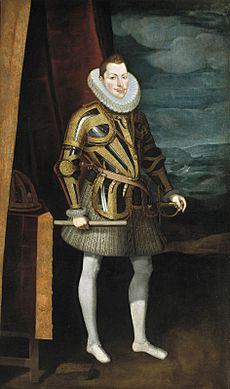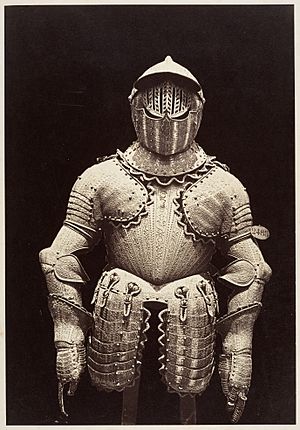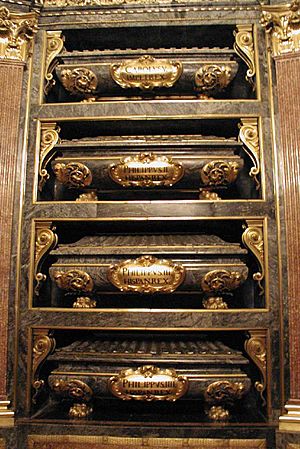Philip III of Spain facts for kids
Quick facts for kids Philip III |
|
|---|---|
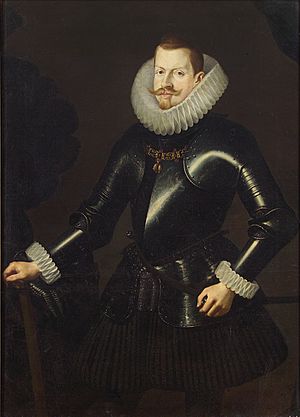
Portrait by Andrés López Polanco, c. 1617
|
|
| King of Spain and Portugal (more...) | |
| Reign | 13 September 1598 – 31 March 1621 |
| Predecessor | Philip II of Spain |
| Successor | Philip IV of Spain |
| Born | 14 April 1578 Royal Alcázar of Madrid, Madrid, Spain |
| Died | 31 March 1621 (aged 42) Madrid, Spain |
| Burial | El Escorial |
| Spouse | |
| Issue | |
| House | Habsburg |
| Father | Philip II of Spain |
| Mother | Anna of Austria |
| Religion | Roman Catholicism |
| Signature |  |
Philip III (born April 14, 1578 – died March 31, 1621) was a powerful King of Spain. He also ruled as King of Portugal, Naples, Sicily, and Sardinia. Plus, he was the Duke of Milan. He became king in 1598 and ruled until he died in 1621.
Contents
Philip III's Family Background
Philip III was part of the important House of Habsburg family. He was born in Madrid, Spain. His father was King Philip II of Spain. His mother was Anna of Austria, who was also his father's niece. Anna's father was Maximilian II, the Holy Roman Emperor.
Philip III's Time as King
Philip III was sometimes called Philip the Pious in Spain. However, people in other countries often saw his rule in a negative way.
The King's Trusted Advisor
Soon after Philip became king, his friend Francisco Gómez de Sandoval became a royal advisor. Lerma quickly became a valido, which means a very trusted royal favorite. He became so powerful that all government matters had to go through him first. King Philip trusted Lerma so much that he told everyone to send all official business to Lerma before it reached him. Many people at the time criticized the king for relying so much on his chief minister.
Over time, Lerma's power started to weaken. His family had too much control, which made many enemies. People also noticed that Lerma was getting very rich while in office, which caused a scandal. Even so, Philip remained close to Lerma. He even helped Lerma become a cardinal in 1618. This position gave Lerma some protection as his government role ended. After Lerma left, Philip announced that he would rule on his own.
Challenges During His Rule
Philip III's time as king faced big economic problems in Spain. There was a Famine in the 1590s because of bad harvests. Then, from 1599 to 1600, a terrible outbreak of bubonic plague swept across Spain. This plague killed more than 10% of the population. These events made the country much weaker economically.
Financially, the kingdom was also in trouble. Philip inherited huge debts from his father, Philip II. He did not get much money from the regional parliaments, called cortes.
Ending and Starting Wars
When Philip became king, he inherited two major wars from his father. These were the long-running Dutch revolt and the Anglo–Spanish War with England. Both wars eventually ended with peace agreements. The Treaty of London was signed in 1604, ending the war with England. A truce, called the Twelve Years' Truce, was signed with the Dutch in 1609.
In the last years of Philip's rule, Spain became involved in the beginning of the Thirty Years' War (1618–48). Spain won an important victory in the Holy Roman Empire. This led to the war with the Dutch starting again shortly after Philip died.
Philip III's Policies in the Americas
In the Americas, Philip faced a difficult situation in Chile. The local Mapuche people destroyed seven Spanish cities between 1598 and 1604. About 3,000 Spanish settlers were killed, and 500 Spanish women were captured by the Mapuche.
In response, Philip changed a rule in 1608. He allowed the enslavement of Native Americans captured in war. However, Spanish settlers sometimes misused this rule. For example, they used it to justify capturing people like the Chono from Patagonia, who had never been under Spanish rule or rebelled.
A Jesuit missionary named Luis de Valdivia believed that the Mapuche people would become Christians only if there was peace. He suggested a "Defensive War" policy to Philip. This meant fighting only to defend Spanish lands, hoping to reduce conflict. The king liked this idea and made it official in 1612. By then, the war between the Spanish and Mapuche had been going on for 70 years.
Not everyone agreed with these policies. Some Spanish leaders thought the "Defensive War" gave the Mapuche a chance to get stronger. Others believed that enslaving the Mapuche was a main reason why the war kept going on.
Philip III's Death
Philip III died in Madrid on March 31, 1621. His son, Philip IV, became the next king. There's a funny story that he died from the heat of a charcoal heater because the right official wasn't there to move it. This story is an exaggeration about how strict the court rules were.
Philip III's Legacy
Historians have generally not seen Philip III as a strong king. Some have described him as "undistinguished and insignificant." Others called him a "miserable monarch" whose only good quality was "a total absence of vice." Overall, he is often remembered as "a weak, dim-witted monarch who preferred hunting and traveling to governing."
Philip III's Family Tree
Like many members of the Habsburg family, Philip III's parents were closely related. His father, Philip II, was the child of first cousins. Philip II then married his niece, Anna of Austria, who was also from a cousin marriage. Philip III himself married his first cousin once removed, Margaret of Austria. This pattern of close family marriages continued. It eventually led to the end of the Spanish Habsburg family line with Philip's grandson, Charles II.
| Ancestors of Philip III and his relationship with his wife | ||||||||||||||||||||||||||||||||||||||||||||||||||||||||||||||||||||||||||||||||||||||||||||||||||||||||||||||||||||||||||||||||||||||||||||||||||||||||||||||||||||||||||||||||||||||||||||||||||||||||||||||||||||||||||||||||||||||||||||||||||||||||||||||||||||||||||||||||||||||||||||||||||||||||||||||||||||||||||||||||||||||||||||||||||||||||||||||||||||||||||||||||||||||||||||||||||||||||||||||||||||||||||||||||||||||||||||||||||||||||||||||||||||||||||||||||||||||||||||||||||||||||||||||||||||||||||||||||||||||||||||||||||||||||||||||||||||||||
|---|---|---|---|---|---|---|---|---|---|---|---|---|---|---|---|---|---|---|---|---|---|---|---|---|---|---|---|---|---|---|---|---|---|---|---|---|---|---|---|---|---|---|---|---|---|---|---|---|---|---|---|---|---|---|---|---|---|---|---|---|---|---|---|---|---|---|---|---|---|---|---|---|---|---|---|---|---|---|---|---|---|---|---|---|---|---|---|---|---|---|---|---|---|---|---|---|---|---|---|---|---|---|---|---|---|---|---|---|---|---|---|---|---|---|---|---|---|---|---|---|---|---|---|---|---|---|---|---|---|---|---|---|---|---|---|---|---|---|---|---|---|---|---|---|---|---|---|---|---|---|---|---|---|---|---|---|---|---|---|---|---|---|---|---|---|---|---|---|---|---|---|---|---|---|---|---|---|---|---|---|---|---|---|---|---|---|---|---|---|---|---|---|---|---|---|---|---|---|---|---|---|---|---|---|---|---|---|---|---|---|---|---|---|---|---|---|---|---|---|---|---|---|---|---|---|---|---|---|---|---|---|---|---|---|---|---|---|---|---|---|---|---|---|---|---|---|---|---|---|---|---|---|---|---|---|---|---|---|---|---|---|---|---|---|---|---|---|---|---|---|---|---|---|---|---|---|---|---|---|---|---|---|---|---|---|---|---|---|---|---|---|---|---|---|---|---|---|---|---|---|---|---|---|---|---|---|---|---|---|---|---|---|---|---|---|---|---|---|---|---|---|---|---|---|---|---|---|---|---|---|---|---|---|---|---|---|---|---|---|---|---|---|---|---|---|---|---|---|---|---|---|---|---|---|---|---|---|---|---|---|---|---|---|---|---|---|---|---|---|---|---|---|---|---|---|---|---|---|---|---|---|---|---|---|---|---|---|---|---|---|---|---|---|---|---|---|---|---|---|---|---|---|---|---|---|---|---|---|---|---|---|---|---|---|---|---|---|---|---|---|---|---|---|---|---|---|---|---|---|---|---|---|---|---|---|---|---|---|---|---|---|---|---|---|---|---|---|---|---|---|---|---|---|---|---|---|---|---|---|---|---|---|---|---|---|---|---|---|---|---|---|---|---|---|---|---|---|---|---|---|---|---|---|---|---|---|---|---|---|---|---|---|---|---|---|---|---|---|---|---|---|---|---|---|---|---|---|---|---|---|---|---|---|---|---|---|---|---|---|---|---|---|---|---|---|---|---|---|---|---|---|---|---|---|---|---|---|---|---|---|---|---|---|---|---|---|---|---|---|---|---|---|
|
||||||||||||||||||||||||||||||||||||||||||||||||||||||||||||||||||||||||||||||||||||||||||||||||||||||||||||||||||||||||||||||||||||||||||||||||||||||||||||||||||||||||||||||||||||||||||||||||||||||||||||||||||||||||||||||||||||||||||||||||||||||||||||||||||||||||||||||||||||||||||||||||||||||||||||||||||||||||||||||||||||||||||||||||||||||||||||||||||||||||||||||||||||||||||||||||||||||||||||||||||||||||||||||||||||||||||||||||||||||||||||||||||||||||||||||||||||||||||||||||||||||||||||||||||||||||||||||||||||||||||||||||||||||||||||||||||||||||
| Notes: | ||||||||||||||||||||||||||||||||||||||||||||||||||||||||||||||||||||||||||||||||||||||||||||||||||||||||||||||||||||||||||||||||||||||||||||||||||||||||||||||||||||||||||||||||||||||||||||||||||||||||||||||||||||||||||||||||||||||||||||||||||||||||||||||||||||||||||||||||||||||||||||||||||||||||||||||||||||||||||||||||||||||||||||||||||||||||||||||||||||||||||||||||||||||||||||||||||||||||||||||||||||||||||||||||||||||||||||||||||||||||||||||||||||||||||||||||||||||||||||||||||||||||||||||||||||||||||||||||||||||||||||||||||||||||||||||||||||||||
Interesting Facts About Philip III
- Philip learned Latin, French, Portuguese, and astronomy. He was good at languages.
- However, he was not known for being very intelligent or good at school.
- Philip III was not only his father's son but also his grandnephew.
Images for kids
-
Francisco Goméz de Sandoval y Rojas, Duke of Lerma, Spanish statesman, by Rubens
-
Ambrosio Spinola, one of Philip III's important leaders, by Peter Paul Rubens
-
Rodrigo Calderón, who was executed by Philip III to please the Duke of Lerma's enemies, painted by Peter Paul Rubens
-
The Expulsion of the Moriscos at the port of Dénia, by Vincente Mostre
-
Mateo Alemán, a writer who wrote about the terrible plague and famine during Philip III's reign. Engraving by Pedro Perete
-
The Somerset House Conference between English and Spanish diplomats that ended the Anglo–Spanish War (1585–1604)
-
Statue of Philip III in Madrid, by Giambologna, finished by Pietro Tacca (1616)
-
Portrait by Diego Velázquez (detail)
-
The Battle of White Mountain, 1620, a victory for Philip III's foreign policy
See also
 In Spanish: Felipe III de España para niños
In Spanish: Felipe III de España para niños


